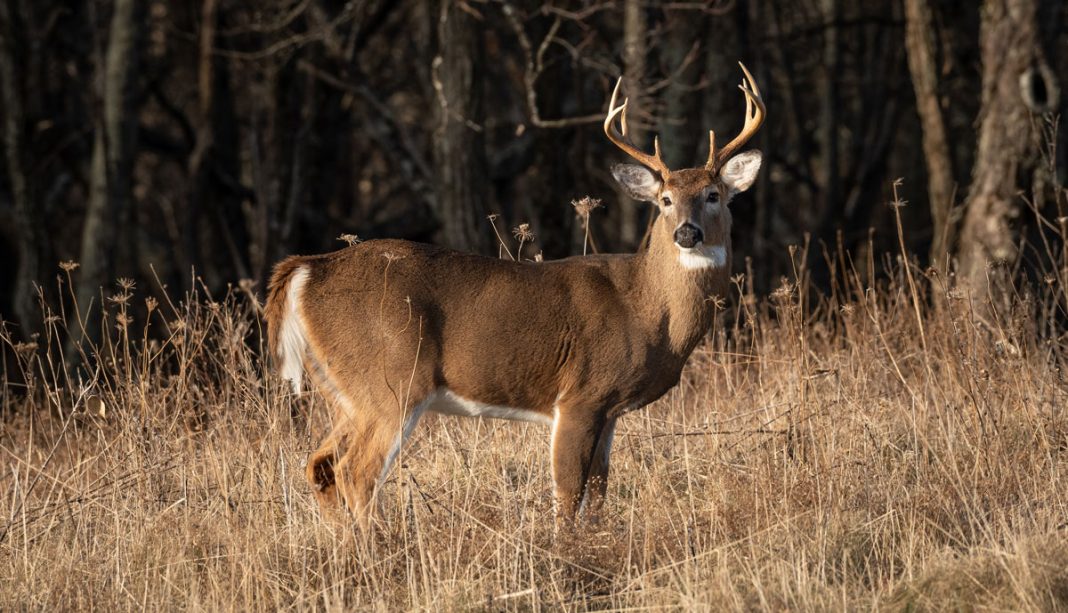And also in midwest US herds
ESTRIE, QC – Deer can get COVID-19 as well as humans. According to Environment and Climate Change Canada (ECCC), three free-ranging white-tailed deer in Quebec have been confirmed as the first detected in Canada of SARS-CoV-2, the virus that causes COVID-19.
“The detection of SARS-CoV-2 in hunter-harvested deer in the Estrie region of Quebec is the first detection of the virus in free-ranging wildlife in Canada,” Samantha Bayard, spokesperson for ECCC, told The Expositor last Friday. “To date, there has been no known transmission of SARS-CoV-2 from white-tailed deer to humans; however, there is a risk that those in contact with infected deer or carcasses could be exposed to SARS-CoV-2.”
An ECCC release December 1 states in part, “on November 29, the National Centre for Foreign Animal Disease (CFIA) confirmed the first detections of SAR-CoV-2 in three free-ranging white-tailed deer in Canada. These deer were sampled between November 6-8, 2021, in the Estrie region of Quebec. Samples for SARS-CoV-2 were collected through a big game registration station in southern Quebec. Similar to findings in the United States, the deer showed no evidence of clinical signs of disease and were all apparently healthy. The World Organization for Animal Health (OIE) was notified on December 1, 2021.
“As this is the first detection of SARS-CoV-2 in wildlife in Canada, information on the impacts and spread of the virus in wild deer populations is currently limited. This finding emphasizes the importance of ongoing surveillance for SARS-CoV-2 in wildlife to increase our understanding about SARS-CoV-2 on the human-animal interface,” the release explains. “Federal, provincial and territorial partners continue to monitor and assess the potential implications of the virus on Canadian wildlife.”
“While there is limited information on animals and COVID-19, the virus has infected multiple species of animals globally, including farmed mink, companion animals (cats, dogs, ferrets), and zoo animals (tigers, lions, gorillas, cougars, otters and others),” the ECCC release says. “Recent reports in the United States have revealed evidence of spillover of SARS-CoV-2 from humans to wild white-tailed deer, with subsequent spread of the virus among deer. There has been no known transmission of SARS-CoV-2 from deer to humans at this time.”
“Until more is known, in addition to following public health guidelines to avoid exposure and as an added precaution to reduce your risk, it is recommended that you wear a well-fitted mask when exposed to respiratory tissues and fluids from deer and avoid splashing/spraying fluids from these tissues as much as possible,” the ECCC release cautions.
Ms. Bayard said, “In addition to the above, follow these general guidelines; do not hunt or consume animals that appear sick or are found dead. Report any sick or dead animals to your local wildlife authority. When handling and dressing the carcass, wear gloves (rubber, latex, nitrile, vinyl) and eye protection (goggles, safety glasses, face shields). Do not eat, drink, or smoke, and avoid touching your face, and process carcasses outdoors or in a well-ventilated area.”
“Keep pets/hunting dogs away from carcasses and discarded tissues,” said Ms. Bayard. “Consult with local authorities for proper carcass disposal. After handling the carcass wash knives and other equipment and surfaces and sanitize with a bleach solution. Remove your gloves and wash your hands with soap and water or use hand sanitizer, and change your clothing and footwear if possible. Cook meat to an internal temperature of 74 degrees Celsius (165 degrees Fahrenheit) to kill any parasites, viruses or bacteria that may be present. The above precautions are particularly important for those who are at higher risk of several COVID-19 illness, as well as those who are not fully vaccinated. Whenever possible, have a fully vaccinated person handle and dress carcasses.”
Keith Munro of the Ontario Federation of Anglers and Hunters (OFAH) said, “the real take home from all of this is to follow public health guidelines. And it shows the important role that hunters play in monitoring diseases. Hundreds of samples are taken every year of deer for CWD (Chronic Waste Disease) in Canada and are used to monitor other diseases in trying to keep wildlife healthy.”
“One thing we really encourage is when someone comes upon a deer that looks sick, is displaying strange activity, to report this,” said Mr. Munro. “This is critical.”
“Human-deer interactions are not limited to hunters, especially in rural and suburban area. Be aware and follow the health protocol guidelines,” said Mr. Munro.
Ms. Bayard told The Expositor, “In August 2021, the USDA Animal and Plant Health Inspection Service reported the detection of SARS-CoV-2 antibodies in samples from white-tailed deer submitted through various wildlife disease surveillance programs in Michigan, Pennsylvania, Illinois, and New York between January 2020 and March 2021. The presence of antibodies provides evidence that deer were exposed to SARS-CoV-2; however, it does not provide information on current infection status. None of the deer in the study were reported to show clinical signs of infection, and the sample could not be used to test for active infections. The possible route of transmission in wild deer remains unclear.”
“In fall 2021, researchers in the United States reported the presence of SARS-CoV-2 in captive and free-living deer in Iowa and Ohio,” said Ms. Bayard. “This research suggests a widespread infection in the deer populations that were sampled and suggests multiple spillover events from humans to deer that were followed by deer-to-deer transmission.”
“Starting in December 2020, the SARS-CoV-2 virus that causes COVID-19 was identified in three separate outbreaks in mink farms in British Columbia, where the virus spread from farm workers to the mink. There is currently no evidence to suggest spillover of SARS-CoV-2 from affected B.C. farms into wildlife, based on surveillance led by the B.C. provincial government,” said Ms. Bayard.
Ms. Bayard also told The Expositor, “new information on COVID-19 emerges every day. Scientists in Canada and around the world are working hard to better understand the virus and its impacts on people, communities, and animals.”
“Deer and other cervid species (such as elk and moose), are abundant across the provinces and territories in Canada,” said Ms. Bayard. “Federal departments, including (ECCC), Canadian Food Inspection Agency (CFIA), Public Health Agency of Canada (PHAC) and Parks Canada have therefore taken a cross-jurisdictional approach along with provinces, territories, multiple universities, and the Canadian Wildlife Health Cooperative (CWHC) to test wild cervids across Canada for the presence of SARS-CoV-2.”
“Samples from deer and other cervid species in Canada are currently being collected and will continue until early 2022, depending on the regions,” said Ms. Bayard. Samples from BC, YK, NWT, AB, SK, MB, NS and NB will be sent for testing at multiple collaborating laboratories, including ECCC’s Wildlife Health Lab (Saskatoon), the Western College of Veterinary Medicine (University of Saskatchewan), and the CFIA National Centre for Foreign Animal Diseases (Winnipeg). Samples from Ontario and Quebec City are being sent to the Sunnybrook Research Institute (Toronto) and the National Microbiological Laboratory (Winnipeg).”
Testing of deer and other cervid species will take place during the fall of 2021 and winter of 2022 as samples are received from partners, said Ms. Bayard. “ECCC continues to assess the potential implications of the virus on Canadian wildlife in collaboration with PHAC, CFIA, Indigenous Services Canada, Parks Canada, Fisheries and Oceans Canada, provincial/territorial counterparts and academia.”
“Surveillance for SARS-CoV-2 and other novel coronaviruses in Canadian wildlife has been underway to address critical gaps in our understanding of COVID-19 at the intersection of humans, animals, and the environment. In addition to surveillance being conducted in cervids, up to 2,200 furbearer and other potentially susceptible species will also be sampled in multiple provinces and territories across Canada. To date, samples that have been analyzed collectively by partner laboratories have resulted in negative tests for SARS-CoV-2 in these species.”
Surveillance targets are species of wildlife that are known to be susceptible to SARS-CoV-2, or have a higher risk of human exposure such as animals in areas with high transmission rates, or all animals commonly harvested by humans. Part of ECCC’s co-ordinated response with other agencies includes the development of wildlife surveillance and handling guides, said Ms. Bayard.
“Earlier this year, a study in the US demonstrated that while-tailed deer could be experimentally infected with SARS-CoV-2, additionally uninfected deer that were housed nearby also became infected,” said Ms. Bayard.
The Canadian Food Inspection Agency’s National Centre for Foreign Animal Disease reported that the three deer in Quebec, “similar to findings in the United States, the deer showed no evidence of clinical signs of disease, and were all apparently healthy,” according to the press release. Previous research found that deer in several states in the northern US were testing positive for the virus. Studies indicated human-to-deer and deer-to-deer transmission.
One study by the US Department of Agriculture found antibodies to the SARS-CoV-2 virus in 40 per cent of the 385 wild deer they sampled in 2021 from the states of New York, Michigan, Pennsylvania and Illinois. These antibodies suggest that the deer were exposed to COVID-19 at some point, the researchers wrote.
However, again according to Canada’s Environment Ministry, “there has been no known transmission of SARS-CoV-2 from deer to humans at this time.” However, the department urges hunters, who might come into contact with deer, to take precautions.




